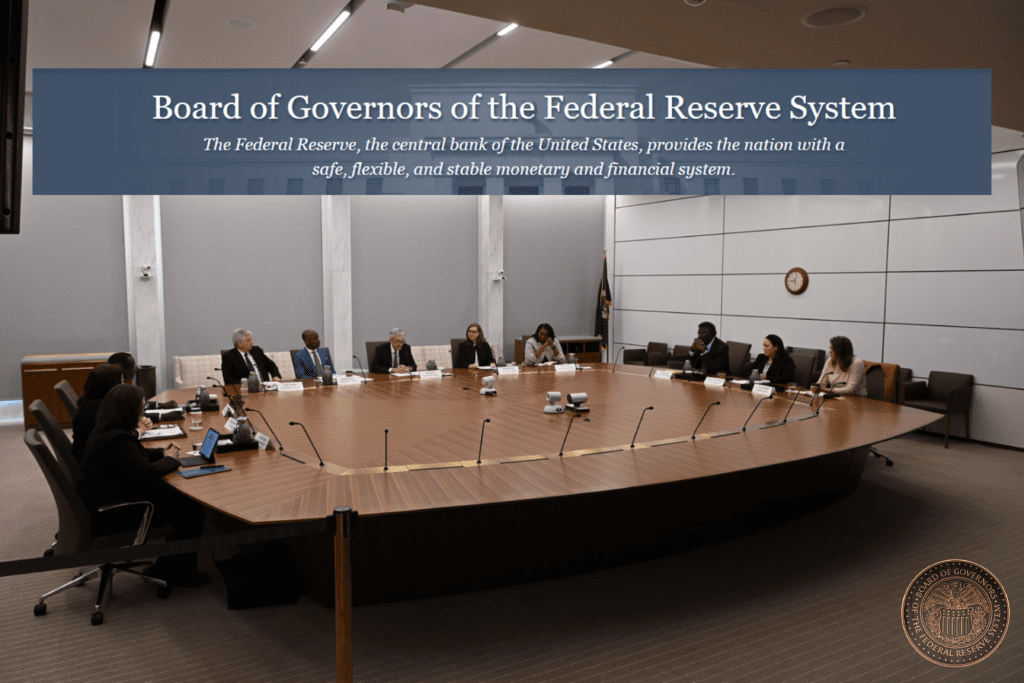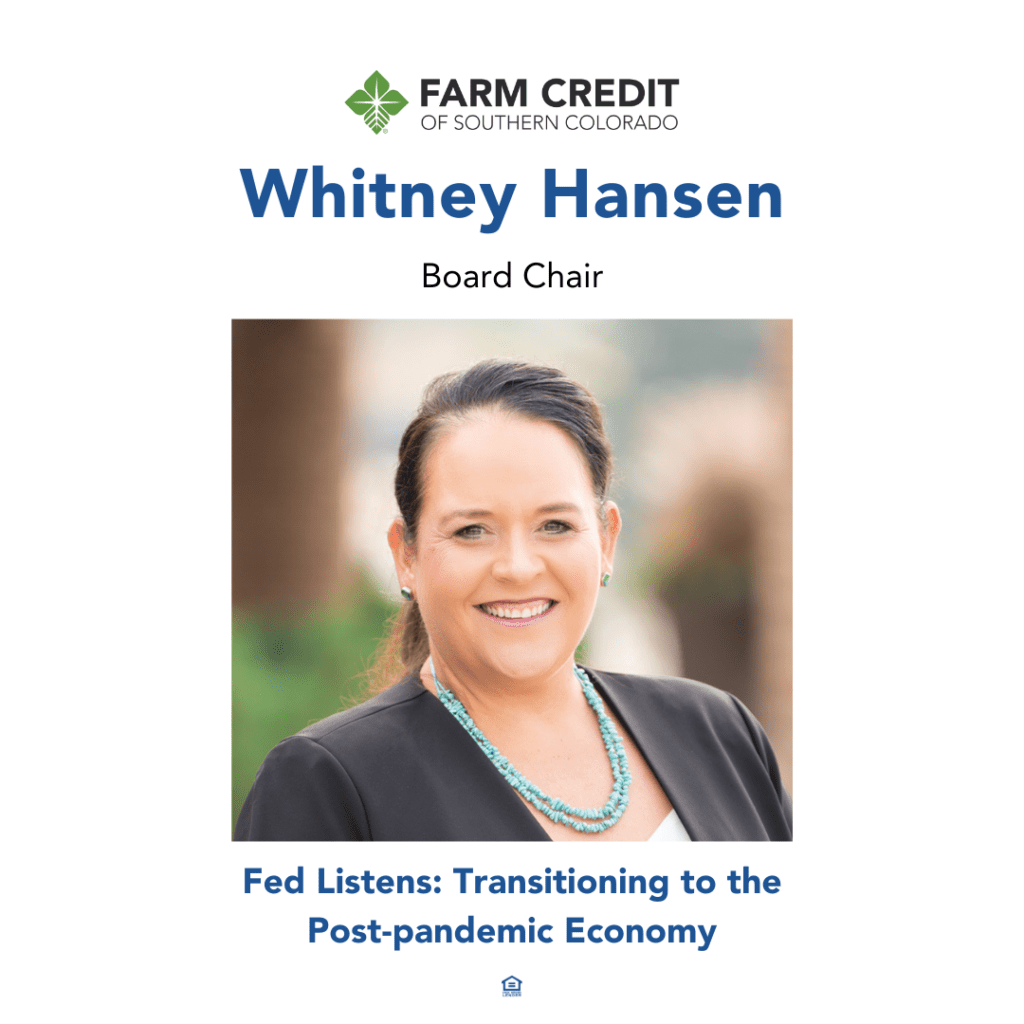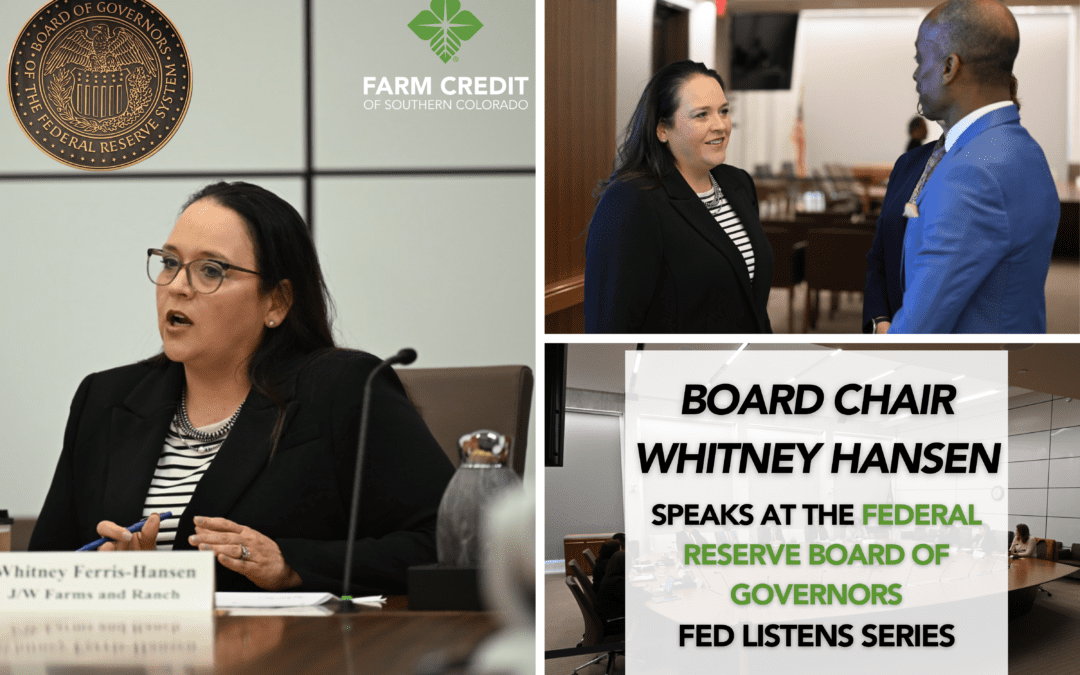We are so proud to announce that our very own Board Director, Whitney Hansen, spoke at the Federal Reserve Board of Governors’ Fed Listens Series last week and spoke about the post-COVID economic effects on the agriculture industry. Read the below transcript of Whitney’s full speech and watch the entire meeting on YouTube to witness the whole conversation.
Congratulations on such a vast accomplishment, Whitney!
Fed Listens: Transitioning to the Post-pandemic Economy, March 22, 2024
(Whitney’s piece starts at the 1:18 mark.)
 ABOUT THE FEDERAL RESERVE: “The Federal Reserve conducts the nation’s monetary policy to promote maximum employment, stable prices, and moderate long-term interest rates in the U.S. economy; promotes the stability of the financial system and seeks to minimize and contain systemic risks through active monitoring and engagement in the U.S. and abroad; promotes the safety and soundness of individual financial institutions and monitors their impact on the financial system as a whole; fosters payment and settlement system safety and efficiency through services to the banking industry and the U.S. government that facilitate U.S.-dollar transactions and payments; and promotes consumer protection and community development through consumer-focused supervision and examination, research and analysis of emerging consumer issues and trends, community economic development activities, and the administration of consumer laws and regulations. Visit the Federal Reserve’s website at www.federalreserve.gov for more information.”
ABOUT THE FEDERAL RESERVE: “The Federal Reserve conducts the nation’s monetary policy to promote maximum employment, stable prices, and moderate long-term interest rates in the U.S. economy; promotes the stability of the financial system and seeks to minimize and contain systemic risks through active monitoring and engagement in the U.S. and abroad; promotes the safety and soundness of individual financial institutions and monitors their impact on the financial system as a whole; fosters payment and settlement system safety and efficiency through services to the banking industry and the U.S. government that facilitate U.S.-dollar transactions and payments; and promotes consumer protection and community development through consumer-focused supervision and examination, research and analysis of emerging consumer issues and trends, community economic development activities, and the administration of consumer laws and regulations. Visit the Federal Reserve’s website at www.federalreserve.gov for more information.”
Insights from Whitney Ferris Hansen, Agribusiness Leader
Philip Jefferson, Vice Chair, Federal Reserve Board: “Okay, to our second panelist, Whitney Ferris-Hansen. Whitney is an owner and operator of JW Farms and Ranch, a family-owned agricultural producer with lot stock operations in southern Oklahoma and farmland in eastern Colorado. She also serves as chair of the board for Farm Credit in Southern Colorado. And my first question for you, Miss Ferris-Hansen, is, can you describe the overall conditions for your business? For example, how do you? How are conditions today compared to a year ago? And have there been changes in the availability and cost of financing over that period of time?”
Whitney Hansen, Board Director at Farm Credit of Southern Colorado: “Thank you, Vice Chairman, for that question, and thank you to the board as a whole for your invitation to speak before you today. I’m truly humbled and honored to represent the American Farmer and Ranchers of an industry I am so passionate about. I’m enthusiastic about this conversation, where it may lead us today, and the educational process that will come on both sides of the table.
“As I begin my remarks to your question, Chairman Jefferson, Vice Chairman Jefferson, I’d like to elaborate a little further on my bio and set the stage for who I am and where I come from. One side of my family settled in southern Oklahoma via covered wagon as they [went] through the immigration process after travels from Ireland. Their name changed from O’Ferris to Ferris.
“The other side of my family went by the name Hucko Chubby as he went through the Choctaw Nation of Oklahoma. Doss Roll, his name became Eddie Gibson. I’m a fifth-generation Oklahoma cattle rancher, married to a fourth-generation Colorado row crop farmer. You need to be careful where you stop on your way to the mountains; you might be there 20 years later.
 “My husband and I are blessed to be parents of two pretty amazing young men. L will be 15 in a couple of short weeks, and Lander’s birthday quickly follows where he will be 12. They’re the definition of farm-raised boys. They work 10-hour days by the age of 12, proficient in [the] breeding season, 2 a.m. [icing] duties, planting schedules, and harvest windows. I say all this to set the stage that the American agriculture industry is not just a job. It’s not a weekend hobby.
“My husband and I are blessed to be parents of two pretty amazing young men. L will be 15 in a couple of short weeks, and Lander’s birthday quickly follows where he will be 12. They’re the definition of farm-raised boys. They work 10-hour days by the age of 12, proficient in [the] breeding season, 2 a.m. [icing] duties, planting schedules, and harvest windows. I say all this to set the stage that the American agriculture industry is not just a job. It’s not a weekend hobby.
“For those of us with boots on the ground daily, it’s not only our livelihood, [but also] our life’s work and the weight of carrying those generations that came before us. As I start to envision what passing this on to the sixth generation in L and Lander will look like, the desire to pass down their inherent legacy, but also the basic want and hope that they will be able to afford this lifestyle when the time comes. As these thoughts become more real with every day, there are two major things right now that keep me up at night, two major things that weren’t on my radar a short 24 months ago, and that is once-in-a-generation interest rates combined with instability in our current commodity prices. It has a stranglehold on the American agriculturalist right now, which leads to a stranglehold on [all] rural America.
“In being asked, ‘What’s the overall condition of our business today?’ I’d sum it up with one word: that’s questionable. In the last 18 months, Jeremy and I have seen 11 increases in our operational line of credit, totaling a change of 500 basis points. That’s a 65% increase in our ability to borrow operational money just for day-to-day businesses. That does not include the change in variable rate land or equipment loans or the actual increase in goods and inputs we [buy], such as fertilizer, chemicals, fuel, labor, freight, parts, insurance, and the list could go on. Even if commodity prices were in a stable place, interest rates alone make profitability questionable right now. An increase in rates is always expected and planned for, but the speed at which these increases happen cannot be risk managed. We could not forward contract grain fast enough to hedge this inflation and these interest rates today.
“This is my story to share, but I want you to know that any production agriculturalist could sit in this chair and tell you the same story. Today, instability in commodity prices is not commodity specific at this time. No farmer is immune from that current perfect storm. In the last 12 months alone, we have seen a 32% drop in corn prices. For every bushel of corn we stored, we have seen a $2 drop in price.
“All of these factors I have mentioned have [directly impacted how] we currently are doing business. More in-house maintenance, more in-house repairs, less outsourcing of all goods and services, no new purchases, no new hires, we’re in a triage mode. One way we’re able to hedge some of this risk and hopefully see the light at the end of the tunnel is our relationship with our banking partner. I’m a firm believer in the Farm Credit system and its place for being a source of educated, reliable lending for rural America, as well as our local and community banks who stand and support, who understand and support, the business we are in. Simply, the big banks would not touch us right now. I believe that every farmer and rancher right now is struggling with the question of money into production costs or money into interest rates.
“There is no right answer here, only a very hard one. But the fact is, we can’t farm without either. So, thank you very much.”

